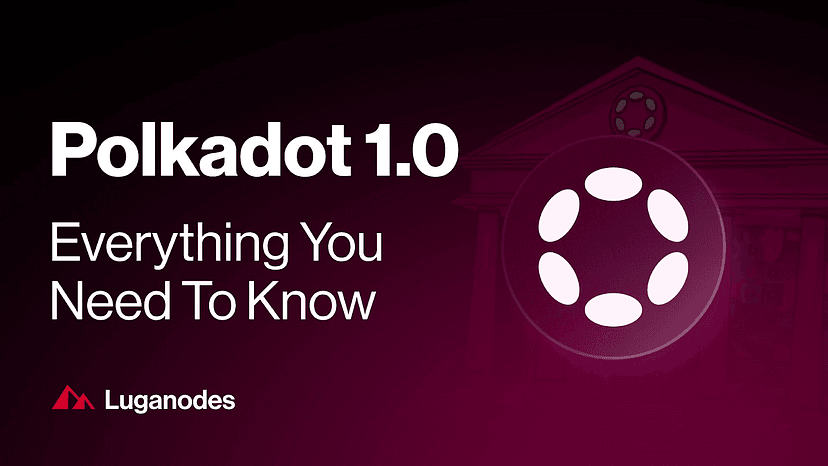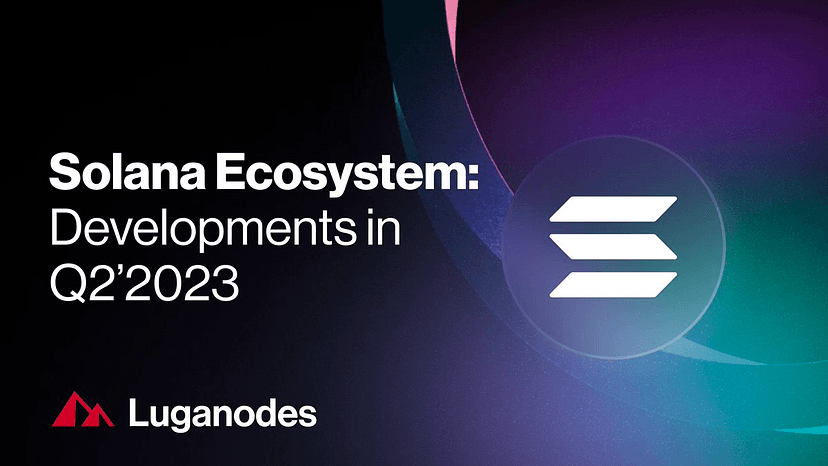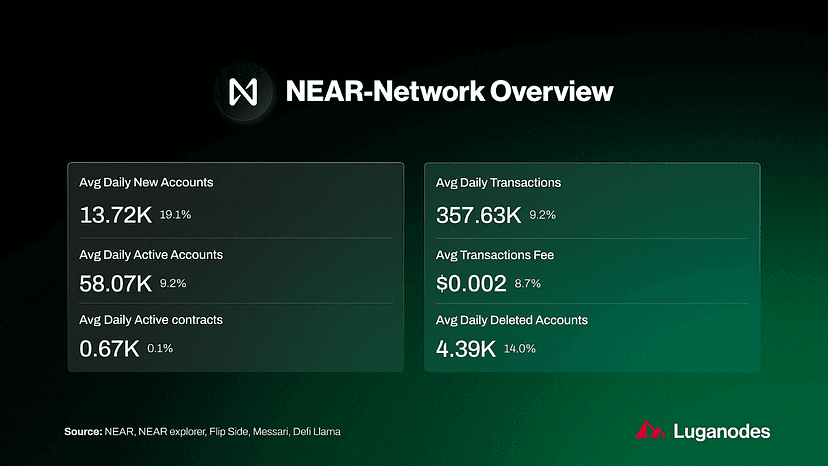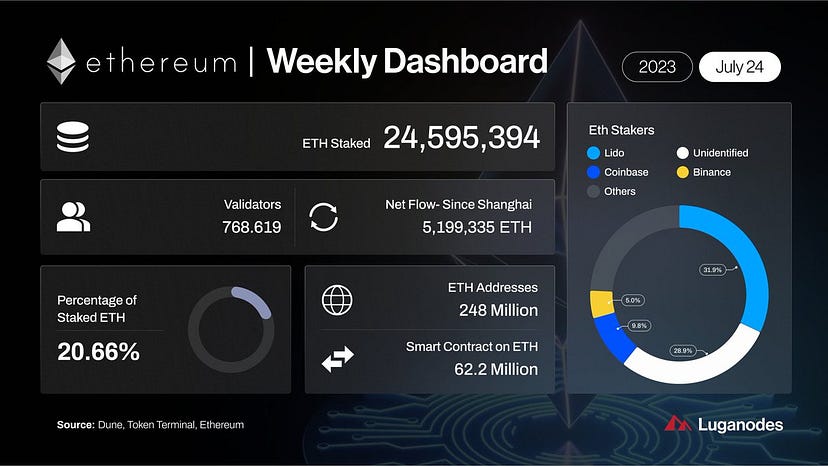5 min read
Luganodes BlockBytes — July Edition 2
Network Updates!

This is BlockBytes, a dedicated series to bring you the latest network updates and major industry breakthroughs. Here’s what we got for the second half of July:

Polkadot has officially released its completed version. As a pioneer in blockchain technology, Polkadot has shattered barriers, marking a significant milestone in the evolution of blockchain technology. Its scalable heterogeneous multi-chain network breaks barriers between blockchains, fostering a single interoperable ecosystem.
The features of Polkadot 1.0 include heterogeneous sharding, relay chain, connected parachains all secured by shared validators, staking system, on-chain governance, cross-chain communication, forkless upgrade, and more. Besides, recent upgrades like dispute slashing, Polkadot OpenGov, LTS releases are able to fortify security, governance, and stability.
Polkadot 1.0 brings revolutionary improvements in blockspace management for developers. To name a few, the innovations include enhanced resource allocation, optimised transaction processing, and improved consensus algorithms, resulting in higher throughput, lower latency, and greater scalability.
Polkadot 1.0 sets the standard for blockchain interoperability, scalability, and resilience. Its goal is to build a better web for all. As for the future, the community will shape Polkadot 2.0, discussing and reaching consensus on diverse visions for its development. From flexible blockspace allocation to ‘treaty-like’ accords between blockchains, and more.

Polygon has rolled out its final announcement of Polygon 2.0. Let’s understand what it is, the changes and upgrades put forward to create the value layer of the internet.
-
Polygon PoS -> ZK L2: Polygon 2.0 embraces zero-knowledge proofs to achieve unlimited scalability and unified liquidity. There is no more fragmented liquidity as the upgrade will bring us seamless cross-chain communication. By incorporating ZK proofs, Polygon PoS will evolve into a validium, leveraging off-chain execution and storage of transactions. This will lead to massive improvements in scalability, with the potential to process thousands of transactions per second compared to Ethereum’s 15 TPS.
-
Protocol Architecture: The four protocol layers of Polygon 2.0 are the staking layer, interop layer, execution layer, and proving layer. Each layer facilitates specific processes, ensuring a seamless and secure blockchain environment.
-
Tokenomics: To fuel growth and decentralisation, Polygon 2.0 changes $MATIC to $POL, a next-generation protocol token. $POL is a hyperproductive token, enabling validators to secure multiple chains and take on various roles for added rewards.
-
Governance: Polygon 2.0 embraces decentralised ownership and decision-making through three governance pillars. Protocol Governance allows open coordination for protocol upgrades. System Smart Contracts Governance upgrades smart contract components. Community Treasury Governance establishes a self-sustainable fund for ecosystem support and public goods. The governance framework ensures secure, scalable, and transparent decision-making.

The remarkable performance at Solana in Q2 2023 showcased its resilience and continued growth in the face of regulatory challenges and network improvements. According to Solana Q2 report by Messari Crypto,
-
Network Overview: Solana experienced a temporary surge in fee-payer activity in May, driven by an unknown program. While the spike didn’t sustain, the average Unique Fee Payer metric still finished up 15.9% QoQ, indicating solid engagement on the network.
-
Staking and Decentralization: Staking on the Solana network remained stable throughout Q2. Total stake and average engaged stake didn’t see significant changes, but the average number of validators decreased by 21.1% QoQ.
-
Ecosystem and Development: Solana’s ecosystem continued to thrive, with developers raising over $600 million in seed funding over the past two years. The Solana Foundation’s growth initiatives, including Convertible Grants and an AI Fund, supported ecosystem expansion.
-
Developer Activity: Solana attracted a significant number of developers, ranking second only to Ethereum in developer activity. While the total number declined to 1,475 by June 2023, ongoing development efforts and collaborations continue to drive progress.
 The NEAR protocol has recently gained significant momentum after the introduction of the Blockchain Operating System (BOS). With stable financials and a resilient network, NEAR remains focused on driving adoption and attracting users to its protocol and BOS.
The NEAR protocol has recently gained significant momentum after the introduction of the Blockchain Operating System (BOS). With stable financials and a resilient network, NEAR remains focused on driving adoption and attracting users to its protocol and BOS.
- Transactions & Users: NEAR witnessed consistent transaction activity in Q2, handling an average of 358k daily transactions with fees remaining below $0.01. The network maintained an average of 58k active accounts per day, showcasing sustained user engagement.
NEAR’s user base expanded significantly with NEAR Social, the social layer of the BOS. Within just four months, NEAR Social attracted over 15k user accounts, becoming the central hub of activity on the BOS. Users own their data, & customizable widgets foster innovation.
-
Ecosystem & Development: NEAR’s ecosystem continues to thrive with key metrics indicating steady progress. Despite a decline in TVL of 39% in Q2, protocols like Burrow & Orderly Network maintained their positions. NEAR Horizon, the accelerator program, supports Web3 founders.
-
Developer Activity: NEAR prioritises developer convenience and supports smart contract development in multiple programming languages The NEAR Dev Hub serves as a resource repository, fostering collaboration and innovation. In Q2, NEAR maintained an average of 700 daily active contracts.
-
Decentralization & Staking: The network boasts 100 block producers, utilising the Thresholded Proof of Stake (PoS) consensus algorithm. Over 534m NEAR tokens (47% of total supply) are staked, ensuring network security and rewarding validators.
Lido Continues Its Support to Ethereum


Ethereum’s ecosystem is growing stronger with 24M+ $ETH staked, and continuous efforts from players like Lido Finance, driving decentralisation by empowering more node operators and simplifying staking for users.
Among all, Lido Finance ranked #1 in net new deposits to the Ethereum Beacon Chain, staking 135.9k ETH in just one week. Total $ETH staked reached an impressive 25,690,919, crossing 32% market share.
About Luganodes
Luganodes is a world-class, Swiss-operated, non-custodial blockchain infrastructure provider that has rapidly gained recognition in the industry for offering institutional-grade services. It was born out of the Lugano Plan B Program, an initiative driven by Tether and the City of Lugano. Luganodes maintains an exceptional 99.9% uptime with round-the-clock monitoring by SRE experts. With support for 45+ PoS networks, it ranks among the top validators on Polygon, Polkadot, Sui, and Tron. Luganodes prioritizes security and compliance, holding the distinction of being one of the first staking providers to adhere to all SOC 2 Type II, GDPR, and ISO 27001 standards as well as offering Chainproof insurance to institutional clients.
The information herein is for general informational purposes only and does not constitute legal, business, tax, professional, financial, or investment advice. No warranties are made regarding its accuracy, correctness, completeness, or reliability. Luganodes and its affiliates disclaim all liability for any losses or damages arising from reliance on this information. Luganodes is not obligated to update or amend any content. Use of this at your own risk. For any advice, please consult a qualified professional.